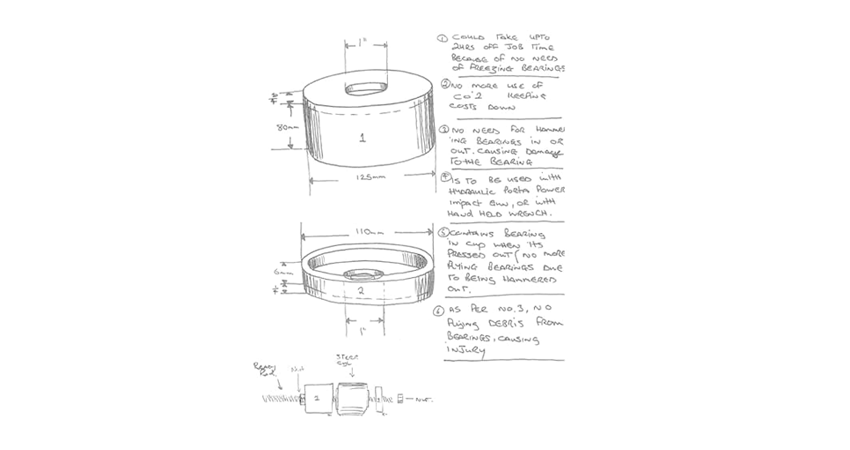Finding ways to operate more safely and efficiently requires hard work, critical thinking, and occasionally, invention, something Chris English, Heavy Mobile Mechanic at Greenhills Operations (GHO) knows a thing or two about.
Opportunity
A common activity undertaken in the heavy mobile maintenance workshop is the changeout of the steering bearings on haul trucks, which takes place around 236 times a year.
In January 2016, the Reliability and Maintenance Engineering (R&ME) group was approached by a maintenance supervisor and asked to evaluate the feasibility of developing a new tool conceived by Chris for removing old bearings and inserting new ones into the steering mechanisms more safely and efficiently.
Traditionally, a hammer had been used for removing and inserting these steering bearings into the steering mechanisms; however, this method presented two safety risks. First, there was a possibility that the bearings could eject from the bore and injure someone. Second, because the bearings are made of 'hardened' steel, there was potential for them to shatter upon impact with the hammer, creating flying shrapnel in the workshop.
In addition, the conventional hammer method was less efficient overall, and due to the interference fit, it was difficult to drive the bearing into the bore squarely. Furthermore, the hammer method is not an appropriate way to install bearings into housings as the bearings can be damaged in the process, which impacts the reliability of trucks and compromises production and safety performances.
Using this method, the removal and installation procedure took, on average, two hours, and finding a way to minimize the mean down time of the fleet through quicker, more efficient truck repairs was an important area for continuous improvement.
Action
R&ME received a conceptual design of a new steering bearing tool from Chris, with sketches and a list of benefits. After an initial review, the group then further developed Chris's design during a brainstorming session with a group of tradespeople.
The new tool's design works by applying an axial load onto the outer race of the bearing. A standard 3/4" impact gun or a hand-held wrench can be used to turn the nut to drive the bearing out. During bearing removal, the 'catching cup' prevents the bearing from falling to the ground, thus eliminating the possibility of injuring workers. If a hand-held wrench is used to turn the nut to drive the bearing out, then no additional energy sources are introduced into this activity, thus no additional risks need to be controlled.
The final product was made entirely from standard materials, with the exception of one component that was machined at a local machineshop, which kept the total fabrication cost under $500.
Benefit
The tool was presented to the crews in April 2016, who then began incorporating it into steering bearing exchanges. Since then, the use of the tool has reduced the changeout time from two hours to one, while also eliminating the safety risks posed by the hammer method previously used.
Positive feedback regarding the new tool's performance has been received from mechanics, and plans for revisions to further improve the tool's effectiveness are now underway.
It is estimated that GHO can provide an additional 236 hours of working time to their 930E fleet annually as a result of Chris's initiative and ingenuity. Considering the difference in hourly operating cost between the GHO trucks and the rentals from FRO, the annual savings for GHO, based on this improvement, are estimated to be $20,000.
In addition, 236 hours of technicians' time is saved, which can be utilized for other proactive maintenance tasks to drive reliability.

